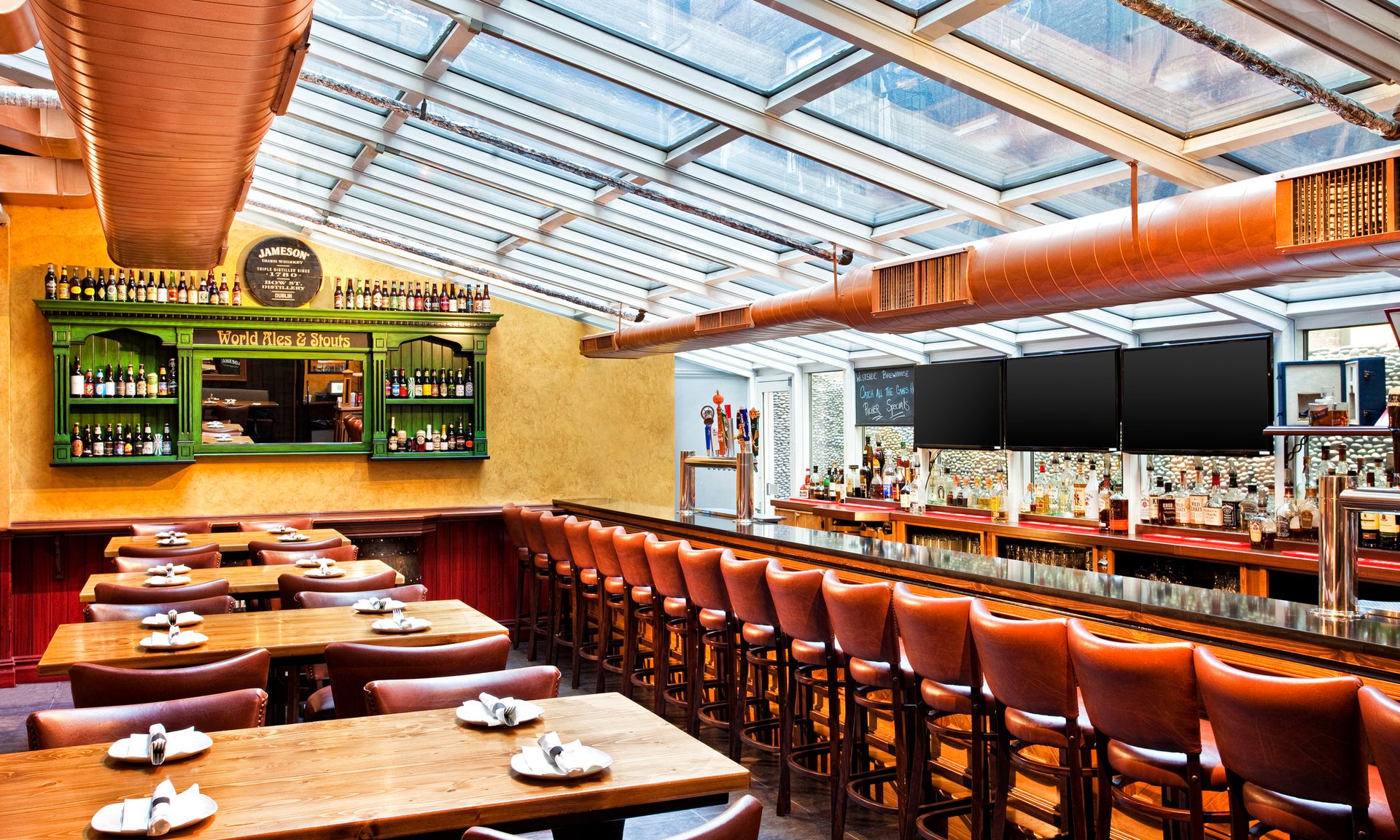What’s the Risk of Opening a Restaurant? Restaurateurs Weigh In
Restauranteurs tell how to minimize the risk of opening a restaurant and how to increase the chance of success.

Many, or all, of the products featured on this page are from our advertising partners who compensate us when you take certain actions on our website or click to take an action on their website. However, this does not influence our evaluations. Our opinions are our own. Here is a list of our partners and here's how we make money.
If you’re a whiz in the kitchen who’s been complimented numerous times about your cooking, you’ve probably toyed around with the idea of opening a restaurant. You think, “I can cook, my food is delicious, so a restaurant would be a no-brainer.” But what's the risk of opening a restaurant?
You conduct research only to find out that the restaurant business is notorious for failure. Some statistics put the food service business failure rates as high as 60% within the first year.
If you look deeper into the numbers, you’ll find there are a more promising statistics around the restaurant business. The U.S. Bureau of Labor Statistics (BLS) puts the number of failed restaurants at closer to 17% within the first year.
This rate is actually lower than the 19% failure rate for other service-based businesses. According to the same study, the median lifespan of a food service business is 4.5 years, slightly longer than other service-based businesses, which last about 4.25 years.
Smart money moves for your business
Grow your small business with tailored insights, recommendations, and expert content.

What's the risk of opening a restaurant?
Consider these statistics:
- According to the National Restaurant Association, the number of restaurant jobs in the U.S. increased 25% from 2010 to 2017.
- Restaurant middle-class job growth was almost four times stronger than the entire economy from 2010-2015.
- The BLS also reported that, in 2014, the average American household spent $2,787 on restaurant meals and takeout, compared to $3,971 on groceries.
Bottom line: the food service is a strong, growing sector of the economy, and many restaurateurs have mastered the art of creating, running, and growing food-service operations.
Though no business is without risk, it’s helpful to know what challenges you’re up against and how to handle those challenges to stay afloat longer. While the risk of opening a restaurant may be high, understanding common challenges and create appropriate fail safes, you could increase your chance of having a successful restaurant.
AD
Boost Your Credit for a Strong Future
Better credit¹ can open up new financial opportunities for your business.
Start building faster¹
On average, users with starting credit under 600 saw +84² points in 1 year with on-time payments.

The power of tri-bureau reporting
Kikoff reports to Equifax, Experian, & TransUnion monthly.
Fast and easy
No credit check. No interest. No hidden fees.
The risk of no access to capital
Any business short on capital is doomed for failure. This is especially so with restaurants. This cash-intensive business requires enough liquidity to cover employee paychecks, supplies, and other operating costs. In fact, cash is one of the biggest risks of opening a restaurant.
Generally, the pool of traditional institutions that lend to restaurants is slim. Even though the statistics show that restaurants are no more inclined to failure than other service-based businesses, banks still tend to stay away.
There’s usually no other way to finance restaurant capital needs outside of venture capital, business profits, or credit cards. In some instances, restaurants can get alternative types of financing like equipment loans, working capital loans, food truck financing, and lines of credit, but this doesn’t mean these options are always available.
Keith Zust, co-owner of Nashville-based restaurant Sea Salt, says food service entrepreneurs should “have a realistic and accurate business plan.”
He goes on to emphasize the need for sufficient resources: “Restaurant owners should have enough capital for the unexpected to weather the first year. The most common issue is not enough capital to withstand the chaos of the unknown.”
» MORE: Restaurant equipment financing
Risk management move
This risk of opening a restaurant can be mitigated by creating a cash-crunch contingency plan. Have sufficient cash reserves in place in cases of emergency. Work with lending partners before you need them to increase your chances of getting help. Keep good accounting records and be ready to present them for loans or credit applications.
The risk of high costs
The amount of money it takes to start a food service business can be daunting: leasehold improvements, food, payroll, waste, insurance, and the list goes on. If costs are not controlled, then cash resources can be a serious risk of opening a restaurant.
President of the Oregon Restaurant and Lodge Association (ORLA) Jason Brandt talks about the three cost buckets that restaurants typically encounter:
- Food
- Labor
- Ancillary costs (think utilities, marketing, rent, etc.)
Portland has one of the “hottest” food markets in the U.S. but has recently been hit with minimum wage hikes and rising real-estate prices. Though it's a food lover’s town and foodie tourist destination, Portland is getting difficult for the foodservice industry to operate as profitably as before.
Brandt says the creative nature of Portlanders comes through when dealing with this challenge: “Rising labor costs have caused many restaurants to adopt a counter service model.” This is where customers order their food at a counter, then a server brings it to their table. More often than not, the customer will also bus their own table.
According to Brandt, the counter service model lends itself to lower labor costs, which could help more businesses stay in business longer.
We can also learn another valuable lesson from Portland: The food truck and food carts have helped many people break into the food-service business with lower barriers to entry.
Risk management move
This risk of opening a restaurant can be mitigated by operating as “lean” as possible. Use discretion dealing with suppliers and choosing a location. Be creative and open to changing things like your menu, service model, or even operating hours to control costs. The restaurateurs of Portland are a great example of cost-saving creativity in a pinch.
The risk of low sales
Many restaurant owners believe their idea is unique. This is a huge risk of opening a restaurant. Because of this, they should have no problem attracting customers. Perhaps the menu is quirky and the decor is slick. The staff is super genial and attentive not to mention the great location with ample foot traffic. They've got systems in place to update social media accounts with awesome food pics. This restaurant is awesome!
The reality of the restaurant business is that you could do everything right and still have dismal sales. Many variables come into play for restaurant receipts. Your food sales could vary based on the time of day or year or even changed based on the food or type of food category. For example, your cafe might sell more drinks in the morning and more sandwiches in the afternoon but on weekdays only.
Melissa Stewart, executive director of the Greater Houston Restaurant Association (GHRA), is also in a “hot” food service market. In fact, Zagat named Houston the top eating out city of 2013 (meaning the city’s population eats out the most often).
The GHRA sees restaurateurs fall prey to slow sales all too often. “A restaurant will open three locations and get tons of media attention in the beginning which causes an initial income spike,” Stewart says.
However, many restaurants do too much too soon. “Once the buzz dies down and the traffic is slower," she says, "many owners end up closing their doors.”
Risk management move
Avoid this risk of opening a restaurant by researching your market thoroughly. Don’t be afraid to start small and nimble. Catering, food carts/trucks, and farmer's markets are all good ways to test a market before going full-monty. Don’t forget to put an emphasis on marketing: hire someone to manage Yelp and Google listings and promote your business on social media.
The risk of inexperience
If you are a newbie restaurateur all of the risk factors can be magnified with inexperience. In fact, Stanford researchers who studied small businesses in Texas between 1990 and 2011 concluded that entrepreneurs who failed once in business were more likely to succeed the second time around. If some didn't reach success on the second go round, each successive attempt at business was garnered more success.
The sobering reality is that newer business owners will make mistakes. Sometimes they’ll affect the business in inconvenient or disastrous ways. It’s a risk that is inevitable, however we know every business owner has to start somewhere.
Risk management move
Get a mentor or a more experienced partner to help run the restaurant. Running ideas by someone else and being open to feedback can help you get your feet wet in the food service business before you're ready to take it on yourself.
Starting a restaurant, or any business, can be risky. There is considerable risk of opening a restaurant—if you're not prepared to mitigate the common challenges.
There’s no guarantee that things will work out. But these risks are not unique to food service, and if you take the right steps, there are many ways you can handle the risks and be successful in food service after all.
This article originally appeared on JustBusiness, a subsidiary of NerdWallet.
Article sources
NerdWallet writers are subject matter authorities who use primary,
trustworthy sources to inform their work, including peer-reviewed
studies, government websites, academic research and interviews with
industry experts. All content is fact-checked for accuracy, timeliness
and relevance. You can learn more about NerdWallet's high
standards for journalism by reading our
editorial guidelines.
Related articles








